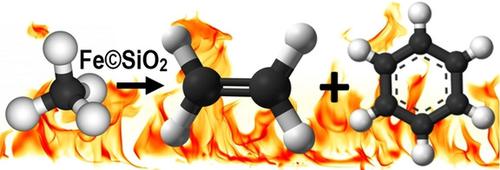当前位置:
X-MOL 学术
›
ChemCatChem
›
论文详情
Our official English website, www.x-mol.net, welcomes your feedback! (Note: you will need to create a separate account there.)
Influence of Axial Temperature Profiles on Fe/SiO2 Catalyzed Non‐oxidative Coupling of Methane
ChemCatChem ( IF 4.5 ) Pub Date : 2020-11-30 , DOI: 10.1002/cctc.202001785 Rolf S. Postma 1 , Leon Lefferts 1
ChemCatChem ( IF 4.5 ) Pub Date : 2020-11-30 , DOI: 10.1002/cctc.202001785 Rolf S. Postma 1 , Leon Lefferts 1
Affiliation

|
The effect of the axial temperature profile upstream and downstream of catalyst bed on the performance of non‐oxidative‐coupling‐of‐methane (NOCM) over Fe/SiO2 was determined. A three‐zone oven was used with independent temperature control of the catalyst‐zone as well as the zones upstream and downstream. It was found that catalytic initiation followed by residence time at 1000 °C downstream the catalyst bed increases CH4 conversion by a factor of 8, while decreasing carbonaceous deposit selectivity from 40 to 12 C%. Residence time at 1000 °C upstream of the catalyst bed causes deposit formation on the catalyst without significantly influencing methane conversion. A shallow catalyst bed followed by significant residence time at high temperature maximizes methane conversion and minimizes coking. This work shows that axial temperature profile and residence time upstream and downstream of the catalyst bed strongly influence the performance in catalytic NOCM.
中文翻译:

轴向温度曲线对Fe / SiO2催化的甲烷非氧化偶联反应的影响
确定了催化剂床上游和下游的轴向温度曲线对Fe / SiO 2上甲烷非氧化偶联性能(NOCM)的影响。使用三区炉,对催化剂区以及上游和下游区进行独立的温度控制。发现在催化剂床下游,催化引发和随后在1000℃下的停留时间增加了CH 4。转化率提高了8倍,同时将碳质沉积物的选择性从40%降低至12%。在催化剂床上游1000°C处的停留时间会在催化剂上形成沉积物,而不会显着影响甲烷的转化率。浅的催化剂床,然后在高温下显着的停留时间,可最大程度地提高甲烷转化率,并最大程度减少焦化。这项工作表明,轴向温度分布和催化剂床上游和下游的停留时间强烈影响催化NOCM的性能。
更新日期:2020-11-30
中文翻译:

轴向温度曲线对Fe / SiO2催化的甲烷非氧化偶联反应的影响
确定了催化剂床上游和下游的轴向温度曲线对Fe / SiO 2上甲烷非氧化偶联性能(NOCM)的影响。使用三区炉,对催化剂区以及上游和下游区进行独立的温度控制。发现在催化剂床下游,催化引发和随后在1000℃下的停留时间增加了CH 4。转化率提高了8倍,同时将碳质沉积物的选择性从40%降低至12%。在催化剂床上游1000°C处的停留时间会在催化剂上形成沉积物,而不会显着影响甲烷的转化率。浅的催化剂床,然后在高温下显着的停留时间,可最大程度地提高甲烷转化率,并最大程度减少焦化。这项工作表明,轴向温度分布和催化剂床上游和下游的停留时间强烈影响催化NOCM的性能。



























 京公网安备 11010802027423号
京公网安备 11010802027423号